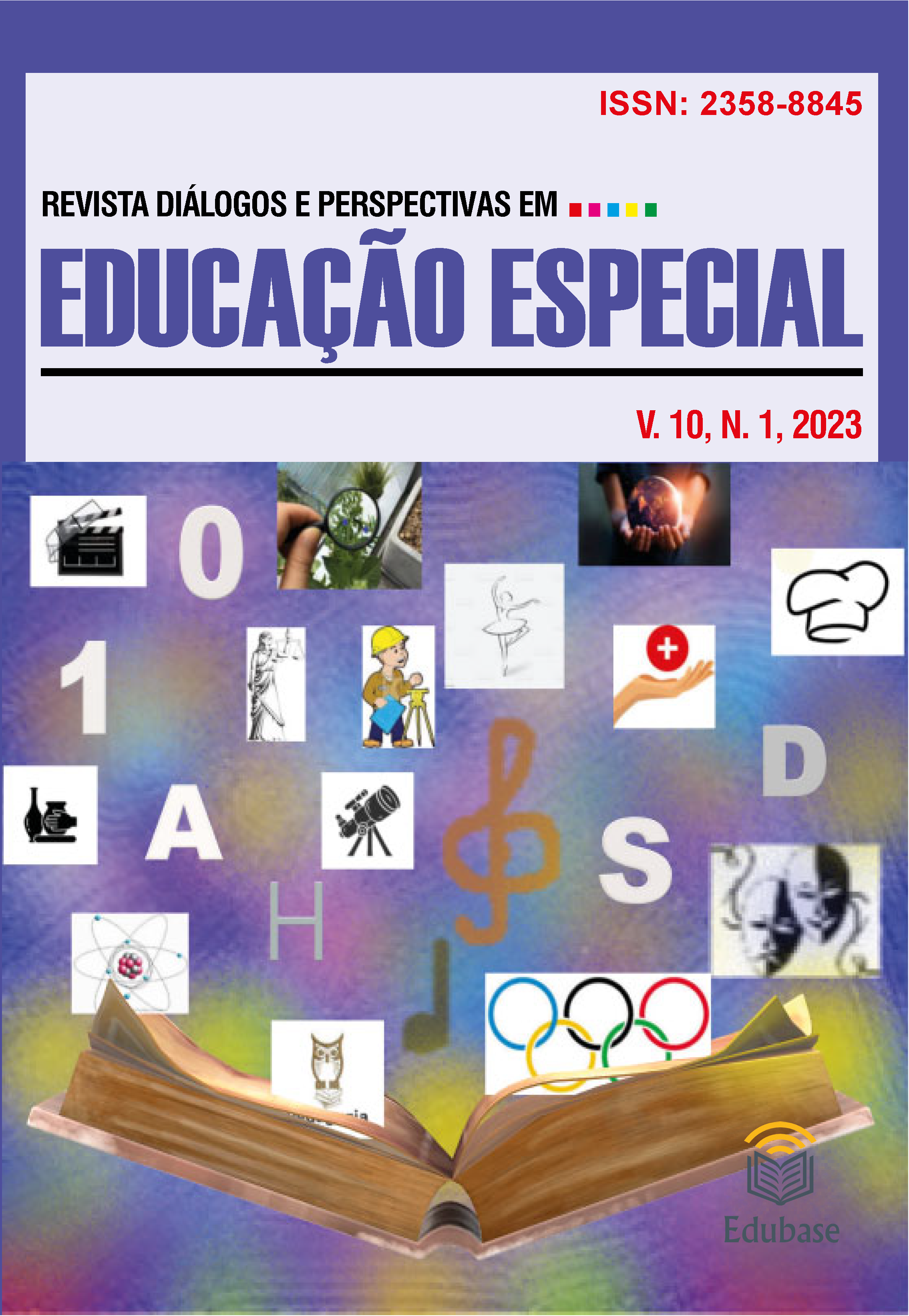The identification Giftedness in The School environment
DOI:
https://doi.org/10.36311/2358-8845.2023.v10n1.p27-40Keywords:
High abilities, Giftedness, Educational trainingAbstract
The World Health Organization estimates that 5% to 8% of the population has characteristics of High Abilities/Super-ability (AH/SD). However, the invisibility of this public in educational spaces is still perceived. This article presents a qualitative and bibliographic research based on the writings of the Three Rings Theory, proposed by Joseph Renzulli, and the Multiple Intelligences, by Howard Gardner. The main problem of the research is the need to raise the awareness of teachers through training courses, in order to clarify the indicators of AH/SD, aiming at the identification of this public in the school environment. It is known that once a student with AH/SD is identified, it is necessary to offer Specialized Educational Services (AEE) and the curriculum enrichment foreseen in the Brazilian Legislation. The results indicate the need to promote training spaces that contemplate from the cognitive, emotional and social characteristics of these students to the offer of care. The sensitization and knowledge of teachers can remove from invisibility students who feel displaced at school, rescuing possible potentials for human development.
Downloads
References
ALMEIDA, Leandro; OLIVEIRA, Ema; SILVA, Manuela; OLIVEIRA, Cristiano. O papel dos professores na identificação de crianças sobredotadas: Impacto de variáveis pessoais dos alunos na avaliação. ANEIS – Associação Nacional para o Estudo e a Intervenção na Sobredotação. Vol. 1, nº 1 e 2, 2000. DOI: Disponível em https://ubibliorum.ubi.pt/bitstream/10400.6/10480/1/2002_O%20Papel%20dos%20Professores%20na%20Identifica%C3%A7%C3%A3o%20de%20Crian%C3%A7as%20Sobredotadas_Constru%C3%A7%C3%A3o%20e%20valida%C3%A7%C3%A3o%20de%20uma%20escala%20de%20despiste.pdf Acesso em: 01 de julho 2021. 163-179.
BRANCHER, Vantoir; FREITAS, Soraia. Altas habilidades/Superdotação: Conversas e Ensaios Acadêmicos. Jundiaí: Paco Editorial, 2011. 212 p.
BRASIL. Saberes e práticas: desenvolvendo competências para o atendimento às necessidades educacionais especiais de alunos com altas habilidades/superdotação. 2. ed. Brasília, 2006. Disponível em http://portal.mec.gov.br/seesp/arquivos/pdf/altashabilidades.pdf Acesso em 20 abril 2022.
FLEITH, Denise de Souza. A construção de práticas educacionais para alunos com altas habilidades/superdotação: volume 3: o aluno e a família / Organização: Denise de Souza Fleith. - Brasília: Ministério da Educação, Secretaria de Educação Especial, 2007. 73 p.: il.
BRASIL. Lei 12.796 de 4 de abril de 2013. Altera a Lei nº 9394 de 20 de dezembro de 1996, que estabelece as diretrizes e bases da educação nacional, para dispor sobre a formação dos profissionais da educação e dar outras providências. Brasília, 2013.
BRASIL. NOTA TÉCNICA nº 04 / 2014 / MEC / SECADI / DPEE. Orientação quanto a documentos comprobatórios de alunos com deficiência, transtornos globais do desenvolvimento e altas habilidades/superdotação no Censo Escolar. Brasília, 2014.
COSTA, L. C. Alternativas de atendimento e estratégias de apoio para os alunos com Altas habilidades/superdotação: relações entre o ensino comum e o Atendimento Educacional Especializado.In: PAVÃO, A. C. O., PAVÃO, S.M.O., NEGRINI, T. Atendimento Educacional Especializado para as Altas habilidades/Superdotação . Santa Maria: FACOS-UFSM, 2018. p. 125-156. Disponível em http://repositorio.ufsm.br/handle/1/18762 Acesso em 10 set. 2022.
FARIAS, E. S. WECHSLER. S. M. Desafios na identificação de alunos intelectualmente dotados. In: VIRGOLIM, A. M. R; KONKIEWITZ, E. C. (Org.). Altas habilidades/superdotação, inteligência e criatividade: uma visão multidisciplinar. Campinas, São Paulo: Papirus, 2014. p. 335-350.
GARDNER, Howard. Inteligências Múltiplas: a teoria na prática. Porto Alegre: Artmed, 1995. 365 p.
HAKIN, Claudia. Superdotação e dupla excepcionalidade: contribuições da neurociência, psicologia, pedagogia e direito aplicado ao tema. Curitiba: Juruá, 2016. 120 p.
INSTITUTO NACIONAL DE ESTUDOS E PESQUISAS EDUCACIONAIS ANÍSIO TEIXEIRA (INEP). Sinopse Estatística da Educação Básica de 2018. Brasília: INEP, 2019. Disponível em: <http://portal.inep.gov.br/web/guest/sinopses-estatisticas-da-educacao-basica> Acesso em: 06 fev. 2021.
PEREIRA, Vera. Superdotação e currículo escolar: Potenciais superiores e seus desafios da perspectiva da educação inclusiva. In: VIRGOLIM, Angela.; KONKIEWITZ, Elisabete. Altas habilidades/Superdotação, inteligência e criatividade: uma visão multidisciplinar. Campinas: Papirus, 2014. p. 373-388.
PÉREZ, Susana.; FREITAS, Soraia. Manual de identificação das altashabilidades/superdotação. Guarapuava: Apprehendere, 2016. 63p.
PORTO ALEGRE. Alunos com altas habilidades e superdotação deverão ter atendimento inclusivo. Disponível em: <https://www.camarapoa.rs.gov.br/noticias/alunos-com-altas-habilidades-e-superdotacao-deverao-ter-atendimento-inclusivo> Acesso em: 20 jan. 2021.
RENZULLI, Joseph.; REIS, S. The Schoolwide Enrichment Model. Mansfield Center, Ct: Creative Learning Press, 1985. p. 323 - 352. Disponível em: https://gifted.uconn.edu/wp-content/uploads/sites/961/2015/01/Systems_and_Models-ReisRenzulli.pdf Acesso em : 10 maio 2022.
RENZULLI, J. S. A concepção de superdotação no modelo dos três anéis: um modelo de desenvolvimento para a promoção da produtividade criativa. In: VIRGOLIM, A.; KONKIEWITZ, E. Altas Habilidades/Superdotação, inteligência e criatividade: uma visão multidisciplinar. Campinas: Papirus, 2014. p. 219-264.
VIRGOLIM, Angela Magda Rodrigues. As vulnerabilidades das altas habilidades e superdotação: questões sociocognitivas e afetivas. Educar em revista. Curitiba, v.37, 2021.
VIRGOLIM, Ângela (Org) Altas habilidades/Superdotação: encorajando potenciais. Brasília: Ministério da educação, Secretaria de Educação Especial, 2007. p.70.
SAMPIERI, Roberto; COLLADO, Carlos; LÚCIO, María. Metodologia de pesquisa. 5ª edição. Porto Alegre: Editora Penso; 2013. 624 p.
WINNER, Ellen. Crianças superdotadas: mitos e realidade. Trad. Sandra Costa. Porto Alegre: Artmed, 1998. 294 p.
Downloads
Published
Issue
Section
License
Copyright (c) 2023

This work is licensed under a Creative Commons Attribution 4.0 International License.
- The works published in RDPEE are the sole responsibility of their authors. The authors grant the journal the right of first publication, with the work simultaneously licensed under the Attribution-CC BY, which allows distribution, remixing, adaptation and creation from the work with recognition of the authorship and initial publication in this journal.
- The authors consent that their articles may be incorporated by RDPEE into indexers and databases that currently exist or may exist in the future; the owners of these databases may reproduce, transmit and distribute the texts, in whole or in part, in any form or means of electronic transmission that exists or may be developed in the future.
Qualis Capes (2017-2020)
Education: B1




